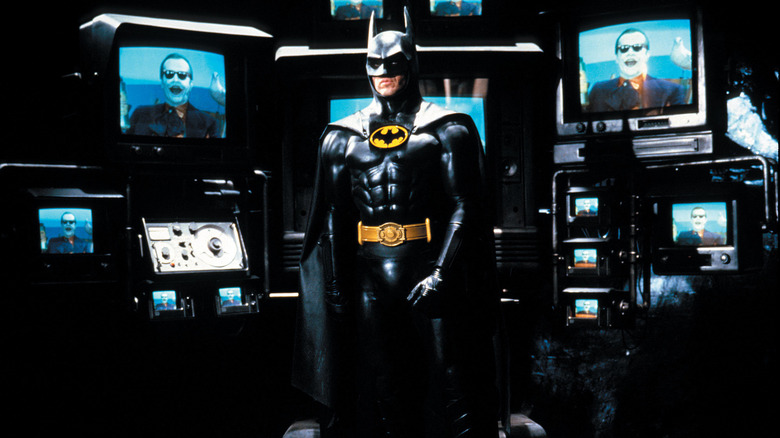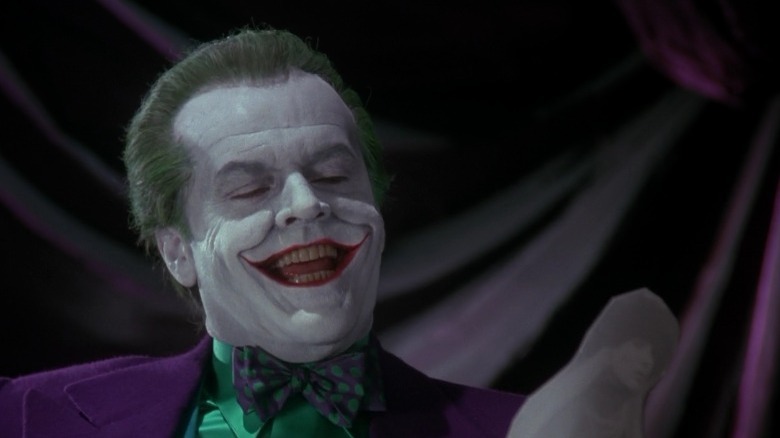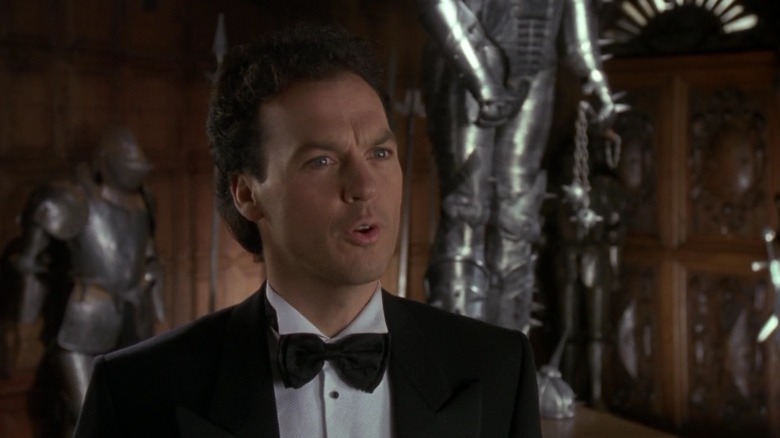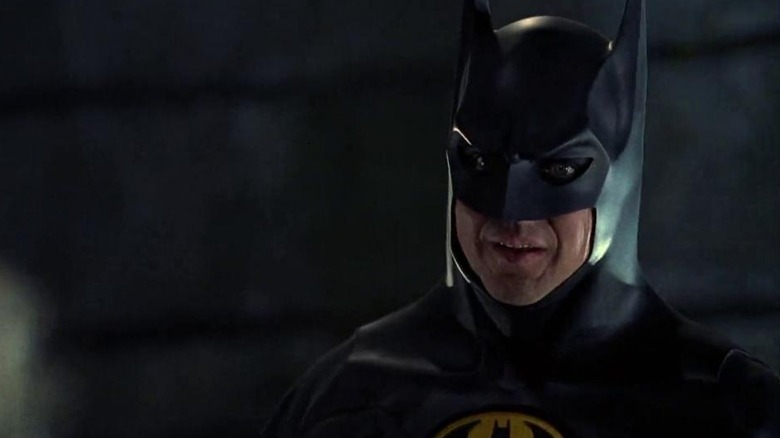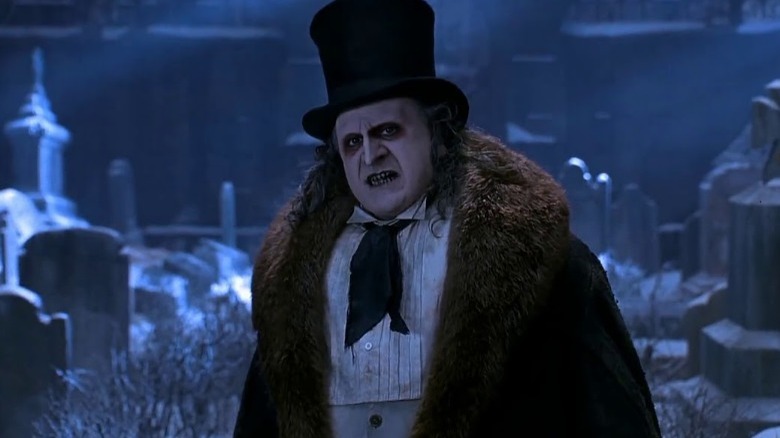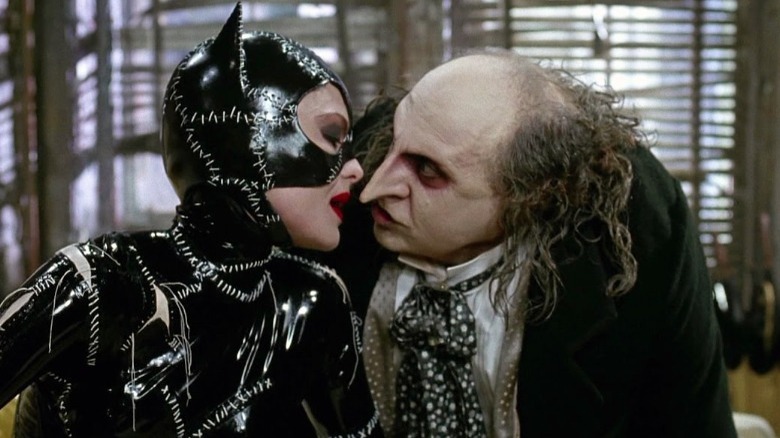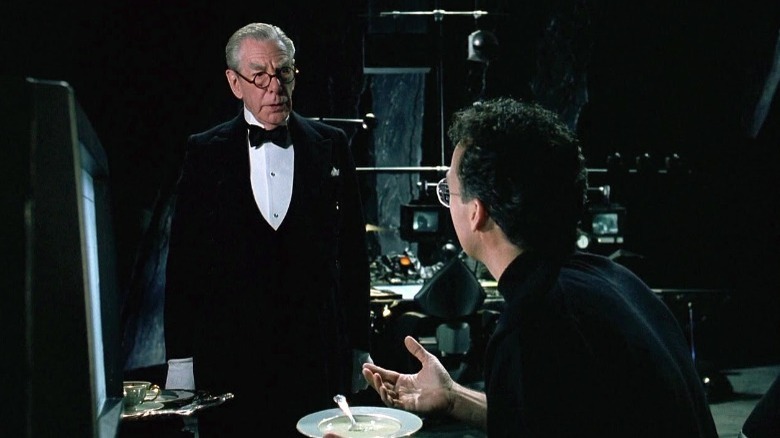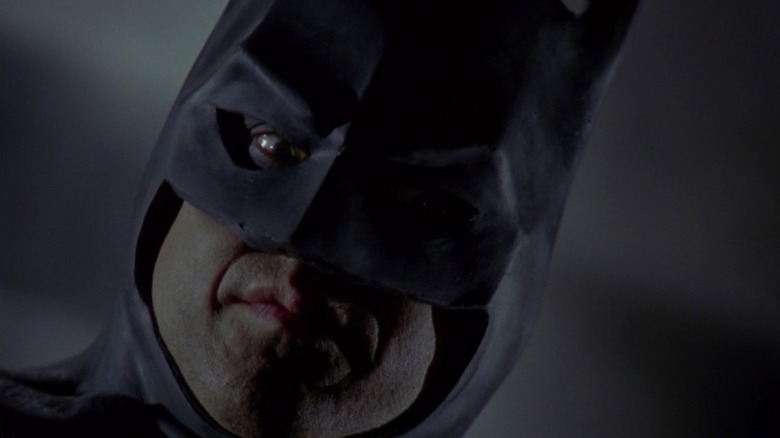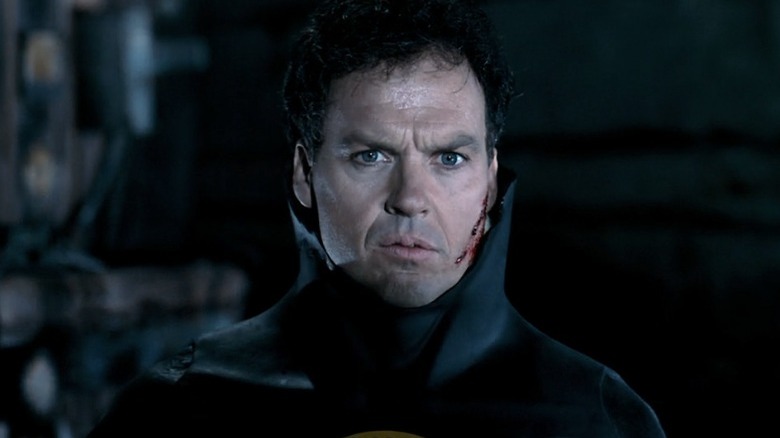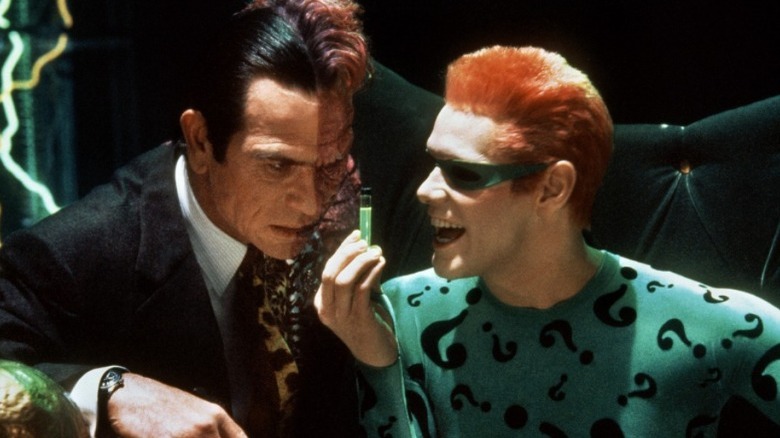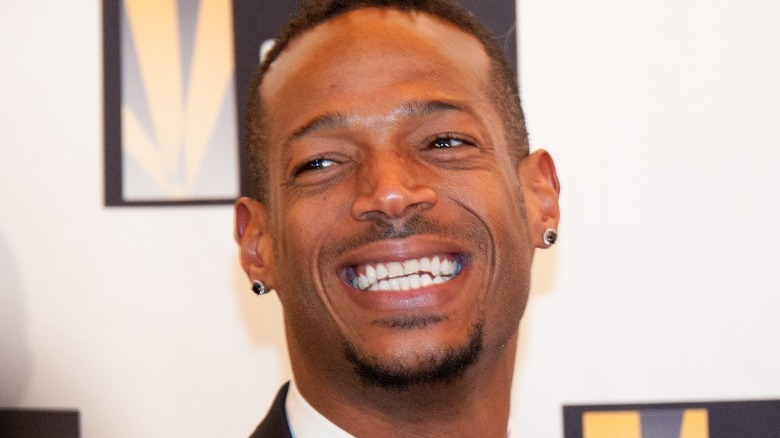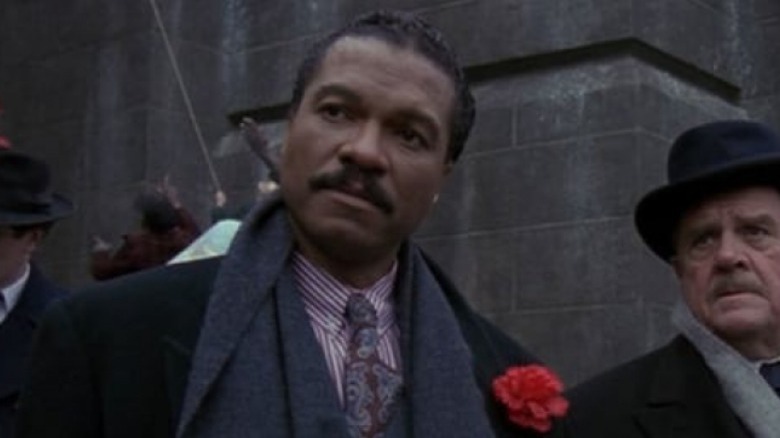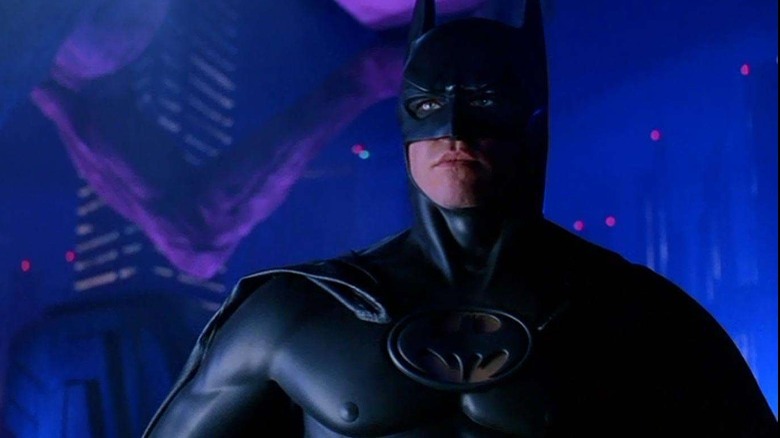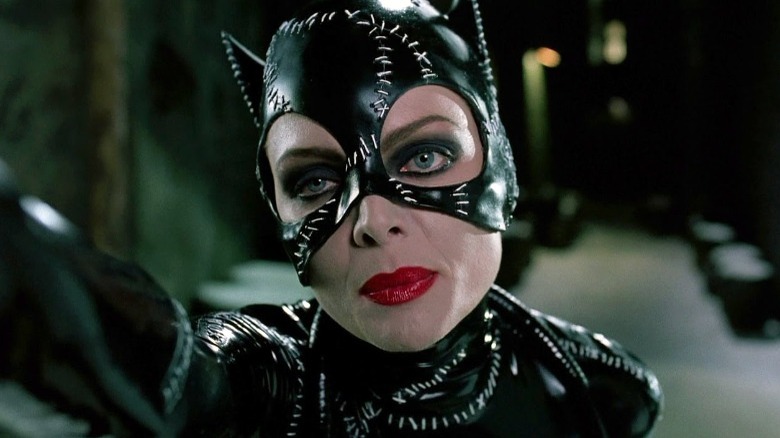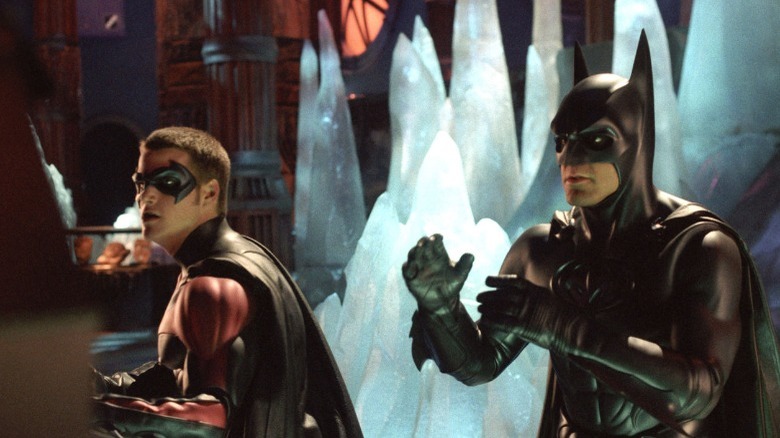Batman Continues: The Full Story Of Tim Burton's Shelved Third Batman Film
Despite being one of the biggest comic book heroes and a hugely popular series for DC Comics, "Batman" was not well represented in film and television until relatively recently. In fact, for many years, the only way to watch the Caped Crusader was via the campy 1966 series starring Adam West and Burt Ward. Even the much-celebrated cartoon "Batman: The Animated Series" didn't arrive until 1992.
Of course, things changed in 1989 when Tim Burton released "Batman." This live-action adaptation featured Michael Keaton in the lead role and Jack Nicholson portraying his arch-enemy, the Joker. A sequel was released three years later in the form of "Batman Returns," which continued the critical and commercial success of its predecessor and cemented the dark, gothic style that has come to define the franchise in the modern era.
While Burton had some input with "Batman Forever" as a producer, he had originally pitched his own third film in the series. Known as "Batman Continues," it would have been a very different movie than what Joel Schumacher ultimately created. Here's the history of that ill-fated film and why it never happened.
Tim Burton directed the first two Batman movies
Although Tim Burton was never a big comic book fan, he was chosen by Warner Bros. to helm "Batman" after the success of "Pee-wee's Big Adventure" and "Beetlejuice." Rather than stick to the colorful and fun style that we saw in the Adam West "Batman" series, Burton instead opted to go for a darker tone that was more mature. This was, in large part, due to the influence of graphic novel stories such as "The Killing Joke" and "The Dark Knight Returns." After numerous aborted screenplays, Sam Hamm was eventually brought on board to create his own script that eventually became the basis for the film.
Despite some controversy surrounding the casting of Michael Keaton as Batman, the film went on to be a critical and commercial success, setting the stage for more "Batman" movies and effectively establishing the presence of Batman on the big screen. Burton returned with Keaton in 1992 for "Batman Returns," a direct sequel that introduced Michelle Pfeiffer as Catwoman and Danny DeVito as The Penguin. While it wasn't a flop, this second film performed poorly at the box office compared to its predecessor and was more divisive with fans and critics alike.
Burton and Keaton were originally set to return for Batman Continues
Even with the rocky road that "Batman Returns" endured when it hit cinema screens, both Tim Burton and Michael Keaton were slated to return to the world of Gotham a third time. This film, tentatively titled "Batman Continues," would have delved deeper into the story as a direct sequel to "Batman Returns." However, a variety of reasons led to both the director and actor stepping back from the "Batman" series to work on other projects instead. This led to the development of "Batman Forever" with a new cast and crew.
Replacements were obviously needed for both Burton and Keaton. Val Kilmer was ultimately chosen to portray the new incarnation of Bruce Wayne, while Joel Schumacher took on directing duties. Schumacher had impressed Warner Bros. with his work on films such as "The Client" and "Flatliners," in addition to gaining the approval of Burton in continuing the series. Casting Batman was a harder job, with such stars as Keanu Reeves, Johnny Depp, Kurt Russell, and even Ethan Hawke all considered for the role. Kilmer beat out these actors for the high-profile role, a decision he ultimately ended up regretting, as the experience was a struggle for him.
Little is known about what the story would have been
Due to the fact that "Batman Continues" was still in the early stages of development when Burton left the project, the details of the story were never properly fleshed out. However, there have been some rumors about what would have happened in this potential third "Batman" movie. The most common reports suggest that the Caped Crusader would have teamed up with Robin in what would have been a direct continuation of both "Batman" and "Batman Returns." The hero and his sidekick would have found themselves face to face with the Riddler and Two-Face, with rumors that Scarecrow might also have featured as a villain, with Catwoman also returning.
How all that played out in the original screenplay might never be known, but it is likely that at least some of the story details that were in "Batman Forever" originated from "Batman Continues." For example, the 1995 film did feature the Riddler and Two-Face forming an alliance to fight against Batman, although there is no Scarecrow and Catwoman is not present in the plot at all. The two villains attempt to use a brain control device to steal knowledge from every citizen in Gotham.
Batman Returns was considered by executives to be too dark
Compared to the whimsy and colorful nature of earlier "Batman" projects, Tim Burton's unique style was a stark contrast. The director took inspiration from the more mature graphic novels of the 1980s and utilized his gothic visuals to create what was a distinct comic book adaptation. This was established in the 1989 film and continued with the sequel before "Batman Forever" took a more colorful approach. Burton has admitted that his vision for "Batman" was considered to be too gloomy and upset some of the higher-ups at the studio.
These concerns only grew with the release of the sequel in 1992, especially with the negative public reception of the Penguin's grotesque appearance and behavior. After all, Burton was given more freedom after his success with the first film. Critics and viewers both took umbrage with the gruesome and grim movie — an opinion that was shared by at least some people at Warner Bros. and may have contributed to the fact that Burton was replaced as director for the third film. Entertainment Weekly quoted one executive at Warner Bros. decrying the atmosphere of the movie. In an article, this unnamed source said, "It's too dark. It's not a lot of fun."
The second film also underperformed at the box office according to Warner Bros.
The theatrical run of "Batman Returns" earned a box office gross of $266 million. Although it became the third highest-grossing film of the year, behind "Aladdin" and "Home Alone 2: Lost in New York," it failed to match the performance of the first "Batman" film, which earned nearly $150 million more. Executives believed that "Batman Returns" was a box office disappointment, and this was seemingly another reason why Warner Bros. was happy to see Tim Burton depart and be replaced with someone who could ensure a bigger box office return for the studio's investment.
The budget for "Batman Returns" was also much higher than its predecessor. Compared to the $35 million figure of "Batman," the sequel had a ballooned cost of potentially $100 million. This was largely due to the fact that the returning cast earned higher salaries and there was a higher marketing budget to help take advantage of the success of the first movie. Having cost more and made less, there is little denying that "Batman Returns" was not as big a financial success as the 1989 film.
McDonald's also played a part in Batman Continues being shelved
Another major issue with "Batman Returns" that led to Warner Bros. looking to go in a new direction for the third film was the outcry about its dark tone. With graphic violence and adult themes, it wasn't seen as appropriate for children. Parents complained that the film was far scarier than any other superhero movie and had been marketed to them in a way that suggested it was a kids' movie.
As part of the marketing for the movie, Warner Bros. partnered with McDonald's for a Happy Meal promotion, with commercials airing during prime time. However, the fast food company faced a backlash when people saw "Batman Returns" and wondered why McDonald's was seemingly pushing such a gritty film on children. Screenwriter Daniel Waters, who attended a public screening of the film that was filled with families detailed the reaction it had. He said: "The lights are coming up after Batman Returns, and it's like kids crying, people acting like they've been punched in the stomach, and like they've been mugged."
McDonald's reaction to this issue may have pushed Warner Bros. to get rid of Burton and try to lighten up the action. The director even addressed the controversy when speaking to Yahoo in 2014. "I think I upset McDonalds," he said in the interview. "[They asked] 'What's that black stuff coming out of the Penguin's mouth. We can't sell Happy Meals with that!'"
Burton felt that the studio didn't want him involved
During the early stages of discussions about a third film, which Burton had expressed some interest in making, it was made clear to him that Warner Bros. wanted to go in a different direction. The director told The Hollywood Reporter that he was effectively pushed out of the franchise and given an executive producer credit to keep quiet. "I realized halfway through my meeting with Warner Bros. that they didn't really want me to do the movie," he explained. "They kept saying, 'Don't you wanna go back and do a movie like Edward Scissorhands? Something smaller?' I said, 'You don't want me to do the movie, do you?'"
Burton was also confused why the studio had such a negative reaction to "Batman Returns" when he didn't consider it that much darker than the first film. Speaking to Yahoo, he went on to explain that he believed the studio didn't know what to do with the film as it was not something executives were familiar with. He said: "It was a weird reaction to 'Batman Returns,' because half the people thought it was lighter than the first one and half the people thought it was darker. I think the studio just thought it was too weird — they wanted to go with something more child or family-friendly. In other words, they didn't want me to do another one."
Michael Keaton left because he was unimpressed with the script
If "Batman Continues" had been made with Tim Burton at the helm, it is likely that Michael Keaton would have stayed on as the Caped Crusader. But the departure of the former director left Keaton in such a difficult position that he eventually left. Warner Bros. even offered him $15 million to reprise his role, but the actor turned it down in favor of pursuing other projects.
Keaton has discussed the fact that he simply didn't like the script he was shown when in negotiations to come back as Batman. New director Joel Schumacher wanted a brighter film, both physically and emotionally, something that Keaton disagreed with. "It sucked," Keaton told The Hollywood Reporter. "I knew it was in trouble when he [Schumacher] said, 'Why does everything have to be so dark?'"
Creative differences with Schumacher seem to have been the major reason that Keaton decided to hang up his cowl. In an episode of "In the Envelope: The Actor's Podcast," the actor explained how he unsuccessfully tried to get the director to change his approach to the third movie, shifting back to something that was more familiar to audiences from Burton's previous two films. When it became clear that Schumacher wouldn't budge, Keaton decided to quit.
Warner Bros. wanted to have a kid-friendly Batman to drive toy sales
A major sticking point for Warner Bros. outside of the box office disappointment and controversy surrounding the noir visuals and intense violence, was the drop in merchandise sales. This can be a lucrative revenue stream for movie studios and even make films that don't perform well in cinemas into successes based on the number of toys, comics, and video games they can sell afterward. Just look at the amount of money franchises like "Star Wars" are able to bring in outside of traditional box office gross.
Unfortunately for Burton, "Batman Returns" simply did not lead to the same amount of merchandise revenue as its predecessor, causing further problems with Warner Bros. The studio wanted to market the "Batman" series more directly to children, as this would allow Warner Bros. to push toy sales and other merchandise more effectively. Having a more family-friendly product to base action figures and other memorabilia was an important factor in deciding how the franchise would move forward, and Burton's darker style was not conducive to that goal.
Marlon Wayans was cast as Robin
Robin was not introduced into the world of the "Batman" film series until the release of "Batman Forever," but that wasn't always going to be the case. According to Marlon Wayans, who is best known for his work in the likes of "White Chicks" and "Scary Movie," he was initially cast as the Dark Knight's sidekick for "Batman Returns." However, the film was seen as too crowded with so many characters already taking on important roles, so his role was cut.
"I got the role, and I was supposed to do the second one," said Wayans to A.V. Club. "I got my wardrobe fitted and everything, and what happened was that there were too many characters, and they felt Robin wouldn't be of service."
In a later interview with Gizmodo, the actor revealed that he had signed a two-picture deal with Warner Bros. and was going to appear in "Batman Continues" until Burton departed. Joel Schumacher wanted to go in a new direction for Robin, and the role was recast with Chris O'Donnell. Despite not being in either movie, Wayans was paid and still receives residual checks. Meanwhile, Robin Williams was reported to be in talks to play the Riddler, a role that eventually went to Jim Carrey.
Billy Dee Williams and Michelle Pfeiffer were set to return
Two familiar faces from Tim Burton's previous "Batman" movies were all set to return in some capacity in "Batman Continues" — at least, that was the initial plan. When Billy Dee Williams signed on to play Harvey Dent for the 1989 film, he had the expectation that he would return to play Two-Face at some point, charting his character's transformation from hero to villain. But in "Batman Forever," the role of Harvey Dent/Two-Face was played by Tommy Lee Jones. This was the result of Joel Schumacher taking over directing duties, according to Williams (via Comic Book).
Michelle Pfeiffer was also rumored to be in for a return to the franchise, reprising her character Catwoman from "Batman Returns." Unlike Williams, Pfeiffer was not specifically replaced, as Catwoman simply doesn't appear in "Batman Forever." The role of a love interest for Bruce Wayne was given to psychologist Dr. Chase Meridian. This character was initially set to be played by Rene Russo of "Lethal Weapon" fame, but when Michael Keaton left the series, she was replaced by the younger Nicole Kidman to better match with Val Kilmer.
Burton was critical of the goofy style in Batman Forever
Since the release of "Batman Forever," Tim Burton has not been afraid to speak out about his opinion of the movie and where he thinks it went wrong. In particular, the director was critical of the goofy style of the third film, which was bizarre in completely new ways compared to his own take on the "Batman" franchise. He told Empire: "But then I was like, 'Wait a minute. Okay. Hold on a second here. You complain about me, I'm too weird, I'm too dark, and then you put nipples on the costume? Go f**k yourself."
While Burton's titles for his two "Batman" films were not exactly imaginatively named, he has also spoken about his disdain for "Batman Forever" as a title. "I always hated those titles like Batman Forever, he wrote in his book, "Burton on Burton" (via Yahoo). "That sounds like a tattoo that somebody would get when they're on drugs or something. Or something some kid would write in the yearbook."
A Catwoman spin-off film with Michelle Pfeiffer was planned
Michelle Pfeiffer's role in "Batman Returns" was one of the popular elements of the film, drawing widespread praise. Figures from Britney Spears to movie critics hailed her performance as Catwoman and the role is widely seen as one of most memorable. Even Michael Keaton lavished praise on her role in the film, saying that she was superb in her portrayal of the character. That may be why Tim Burton had planned to work on a spin-off featuring Selina Kyle as the main protagonist, although the project never went ahead despite the involvement of screenwriter Daniel Waters and producer Denise Di Novi.
Still, fans of the Burton "Batman" series can get a potential look at what the third film might have included: DC Comics created a limited series that included the original Batman and brought back Catwoman and Harvey Dent as portrayed by Pfeiffer and Billy Dee Williams. "Batman 89" ran for six issues and was written by Sam Hamm, who worked on both of Burton's "Batman" movies.
Batman Forever marked a downturn in fortunes for the series
The release of "Batman Forever" marked a turning point in the original "Batman" film series. Achieving mixed reviews, with a Rotten Tomatoes rating of just 39% (compared to 81% for "Batman Returns") there is little denying it saw a drop-off in terms of quality. While "Batman Forever" did fare slightly better at the box office than its predecessor, with a total worldwide gross of $336 million, it still didn't match 1989's "Batman." The film also represented a downturn in the franchise, with "Batman & Robin" — this time starring George Clooney as Bruce Wayne — performing even worse with critics and audiences.
The third and fourth films were so poorly received that Warner Bros. put a hold on live-action film adaptations of Batman until 2005, with the release of the first entry in the "Dark Knight" trilogy. Christopher Nolan went back to a darker and grittier vision of Gotham to great effect, winning plaudits for "Batman Begins," "The Dark Knight," and "The Dark Knight Rises." Batman is now an established name in the DCEU, but has never returned to the eccentric and zany antics of Joel Schumacher's films that abruptly ended the franchise for two decades.
